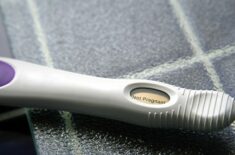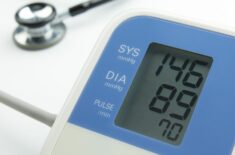Overview
Pregnant women with severe vitamin D deficiency in early pregnancy may give birth to obese children. (1)
We shouldn’t just dismiss this because as many as 95% of pregnant women have vitamin D deficiency in some areas of the world. (2)
In the US, it’s estimated that the prevalence is at 69%, with African American women at a much higher risk due to low dietary intake and their dark skin. (3)
Aside from a higher risk of obesity in children, maternal vitamin D deficiency may also lead to miscarriage and other pregnancy complications. It may also be linked with ASDs (autism spectrum disorders), asthma, rickets (softened, weakened bones), and low birth weight. (4)
What causes vitamin D deficiency, and how can you raise your levels for a healthy pregnancy? Learn more about this below.
What Is The Side Effect Of Low Vitamin D?
Vitamin D, also known as 25(OH)D or 25-Hydroxyvitamin D, is a nutrient our bodies need to regulate calcium and phosphorus levels for healthy bones. It’s also important for immune function.
Calcitriol (1,25-dihydroxyvitamin D) is also important in treating or preventing low levels of calcium in people with low parathyroid hormone levels. It binds to the vitamin D receptor to help us maintain healthy calcium levels. (5)
Everyone needs vitamin D, but moms-to-be experience a higher demand for this nutrient during gestation (pregnancy) because your baby needs plenty of calcium to develop its bones while inside your tummy.
You may be at higher risk for osteoporosis (bone loss) and pregnancy complications if you have low maternal vitamin D status. That’s because your baby uses up your vitamin D reserves. (3)
Therefore, it’s important for you to maintain adequate vitamin D levels for your bone health and to meet the increased demands for this vitamin in your body.
Vitamin D Deficiency By Levels
A blood test to measure levels of 25(OH)D in your blood serum will show whether you’re deficient in vitamin D or not. You don’t need to fast for this type of test.
The IOM (Institute of Medicine) defines vitamin D deficiency as serum levels of 25(OH)D below 20 ng/mL or below 50 nmol/L. (6)
What Happens If Vitamin D Is Low During Pregnancy?
Dangers of Vitamin D Deficiency for Moms
Studies in obstetrics show that the demand for vitamin D greatly increases during the third trimester of pregnancy.
That’s around the time that your baby is growing most of its bone structure. (3)(7)
Low vitamin D levels may pose several adverse effects on pregnant moms:
- Preeclampsia (a serious pregnancy complication characterized by high blood pressure with potential organ damage)
- Gestational diabetes
- Bone fragility or bone loss
- Poor weight gain
- Increased risk for repeated miscarriage
- Higher risk of Cesarean section
- Preterm labor
- Postpartum depression
These studies show that low levels of this vitamin during the first trimester of pregnancy may lead to a higher risk of developing gestational diabetes in the third trimester, preterm labor, Cesarean section, and postpartum depression. (8)
Researchers recommend supplementation with vitamin D to lower the risks of these pregnancy complications, particularly in moms from high-risk groups. (3)(7)
Dangers of Vitamin D Deficiency for Babies
Because your baby needs calcium to develop strong bones in your womb, it may experience some complications if you’re deficient in vitamin D.
If you have low vitamin D levels in your maternal serum, it may lead to the following complications in your neonates (newborn babies or babies less than four weeks old): (3)(9)
- Low birth weight
- Preterm birth
- Neonatal hypocalcemia (low calcium levels in newborn babies)
- Poor bone development and stunted growth
- Rickets (softened or weakened bones)
- Large fontanelle (soft spot on your baby’s head)
- Gestational diabetes mellitus (diabetes in pregnancy)
- Increased risk for autoimmune and infectious diseases
- Possible heart failure
Recent studies in pediatrics also found a link between gestational diabetes mellitus and an increased risk for obesity. (1)(10)
Exposure to very low 25(OH)D concentrations during pregnancy may lead to children with higher body fat percentage and body mass index than those born to moms with adequate vitamin D levels.
Moreover, researchers conclude in a 2017 study published in the British Journal of Psychiatry that vitamin D deficiency during mid-pregnancy may be linked to an increased risk of ASD (autism spectrum disorders) in children. (4)
What Contributes to Vitamin D Deficiency / Risk Factors
Some moms are more likely to develop vitamin D deficiency than others. You may be at higher risk if you: (3)
- Have darker skin
- Use sunscreen
- Regularly wear a veil and long clothing
- Have limited sun exposure
- Prefer to stay indoors
- Are obese (BMI above 30)
Obesity is considered a risk factor because those who are obese may produce vitamin D less rapidly than those with normal weight. (11)
Note that though sunscreen with SPF 50 may prevent skin cancer, this also blocks vitamin D production by preventing the sun’s UV (ultraviolet) rays from entering the skin.
Researchers in a 2013 systematic review published in the British Journal of Nutrition discovered that age might also be a risk factor. (12)
The researchers suggest that neonates (newborns) and bedridden elderly patients from several regions worldwide may have a high risk of insufficiency in vitamin D. That’s shown in lower 25(OH)D values from these populations.
This may be due to lesser exposure to the sun. Moreover, vitamin D production may decrease with age due to a possible decline in skin and body functions. (13)
Prevalence of Vitamin D Deficiency
Considered a worldwide epidemic, vitamin D deficiency in pregnancy has a reported average prevalence of as high as 84% of moms-to-be across the world.
A 2010 study shows that vitamin D deficiency prevalence may be as high as 69% of pregnant women in the US. That’s higher than the 50% figure reported in an earlier study in 2007. (14)(15)
Studies show the high prevalence of vitamin D insufficiency is notable during spring and winter months in pregnant women living in the northern US states. That’s possibly due to these women being exposed to less sunlight during this period. (7)
Surprisingly, prevalence also appears to be high even in Indonesia, a tropical country. In a 2017 study published in the Medical Journal of Indonesia, researchers discovered vitamin D deficiency in as many as 99.6% of pregnant women in Jakarta. (16)
The same goes for another tropical country, Brazil, where vitamin D deficiency was reported in 85% of pregnant women. (17)
How Can I Increase My Vitamin D Level During Pregnancy?
The IOM (Institute of Medicine) Food and Nutrition Board recommends daily dietary reference intakes of 600 IU or more for pregnant women. (18)
To reach optimal vitamin D levels, it may be a good idea for you to increase your sun exposure to 10 minutes for around two to three times a week during early morning hours.
Besides sensible sunlight exposure, researchers also recommend increasing food fortification programs, eating foods that naturally contain vitamin D and vitamin D supplementation. (19)
The NIH (National Institutes of Health) lists these food sources with vitamin D: (18)
- Cod liver oil (1 tbsp) contains 1,360 IU
- Trout (3 oz) contains 645 IU
- Salmon (3 oz) contains 570 IU
- Canned Atlantic sardines (2 sardines) contain 46 IU
- Egg (large) contains 44 IU
- Beef liver (3 oz) contains 42 IU
- Chicken breast (3 oz) contains 4 IU
- Ground beef (3 oz) contains 1.7 IU
But other researchers point out that only very few foods contain enough vitamin D levels, and fortification programs may be inadequate to meet our bodies’ demands for this nutrient.
They recommend supplementing with at least 800-1,000 IU (international units) using vitamin D3 for optimal nutrition in children and adults alike. (20)
The Endocrine Society recommends a prenatal vitaminwith 400 IU vitamin D and an additional supplement with at least 1000 IU vitamin D for pregnant women. (21)
Note that vitamin D has two forms:
- D2 (ergocalciferol) comes from plants
- D3 (cholecalciferol) comes from animals
Vitamin D3 is more easily absorbed and lasts longer in the body than vitamin D2. This is also the form that’s available in supplements you can buy over the counter.
You’ll need a prescription to purchase vitamin D2 supplements. These are usually used for maternal vitamin D deficiency in vegan or vegetarian moms.
Can You Take Vitamin D While Pregnant?
Even with the widespread use of prenatal vitamins and multivitamins, studies still discovered low blood levels of vitamin D in pregnant women.
Researchers believe that’s due to prenatals only containing 400 IU of vitamin D. So a separate vitamin D supplement (up to 4,000 IU daily) may be needed in antenatal (prenatal) care. (3)
Though the IOM only recommends 600 IU of vitamin D per day for pregnant women, some studies show that a higher dose may be better at lowering the risks of pregnancy complications due to this nutrient deficiency.
Supplementation of at least 1000 IU/day may reduce the risk of diabetes mellitus complications. (22)
A 2011 clinical trial published in the Journal of Bone and Mineral Research shows that vitamin D supplementation of 4,000 IU/day may be safe and effective for pregnant women to increase low levels of serum 25(OH)D (also called serum 25-hydroxyvitamin D). (23)
Screening for Vitamin D Deficiency
Although there’s a high prevalence of vitamin D deficiency in the US, ACOG (American College of Obstetricians and Gynecologists) doesn’t recommend routine screening for all pregnant women. (24)
But many researchers and nutritional experts hope this will change soon.
Registered dietitian Lily Nichols notes in her book, Real Food in Pregnancy, that routine screening and supplementation should be done to address vitamin D deficiency in pregnant women.
She points out that vitamin D supplementation is not just inexpensive but may also be effective in preventing related pregnancy complications by reversing vitamin D deficiency. (25)
Taking Calcium and Vitamin D Supplements Together in Pregnancy
Because vitamin D plays an important role in calcium absorption, you mustn’t take calcium and vitamin D supplements simultaneously.
Researchers in a 2016 meta-analysis published in the CDSR (Cochrane Database of Systematic Reviews concluded that a combination of vitamin D and calcium might increase the risk of preterm birth. (26)
Getting Too Much Vitamin D
Vitamin D toxicity is a condition caused by having too much of this vitamin in your body. Thankfully, this is rare.
Symptoms of vitamin D toxicity may include:
- Ataxia (neurological condition, causes stumbling and slurring of words)
- Confusion
- Constipation
- Increased thirst and urination
- Nausea
- Poor appetite
- Weakness
Researchers believe this may happen after regular excessive vitamin D intake (more than 10,000 IU per day), leading to irreversible kidney failure. (13)
How is Vitamin D Linked to Fertility?
Recent studies show that women with higher vitamin D levels may be more likely to have positive IVF (in vitro fertilization) outcomes, leading to higher chances of conceiving.
Researchers suggest further studies to develop guidelines for using vitamin D supplementation to assist infertility treatments and procedures. (27)(28)
Vitamin D for Breastfeeding Moms
The Endocrine Society recommends vitamin D supplementation of at least 1400–1500 IU per day for breastfeeding moms. (29)
Meanwhile, the AAP (American Academy of Pediatrics) recommends that exclusively breastfed babies receive vitamin D supplements of 400 IU/day. (30)
REFERENCES
(1) Daraki V, Roumeliotaki T, Chalkiadaki G, Katrinaki M, Karachaliou M, Leventakou V, Vafeiadi M, Sarri K, Vassilaki M, Papavasiliou S, Kogevinas M, Chatzi L. Low maternal vitamin D status in pregnancy increases the risk of childhood obesity. Pediatr Obes. 2018 Aug;13(8):467-475. doi: 10.1111/ijpo.12267. Epub 2018 Jan 28. PMID: 29377526.
(2) https://pubmed.ncbi.nlm.nih.gov/31117971/
(3) Mulligan, M. L., Felton, S. K., Riek, A. E., & Bernal-Mizrachi, C. (2010). Implications of vitamin D deficiency in pregnancy and lactation. Am J Obstet Gynecol. American journal of obstetrics and gynecology, 202(5), 429.e1–429.e4299. https://doi.org/10.1016/j.ajog.2009.09.002. https://www.ncbi.nlm.nih.gov/pmc/articles/PMC3540805/
(4) https://www.ncbi.nlm.nih.gov/pmc/articles/PMC5385921/
(5) https://www.ncbi.nlm.nih.gov/pmc/articles/PMC6695859/
(6) https://www.ncbi.nlm.nih.gov/books/NBK263420/
(7) Bodnar LM, Simhan, H. N., Powers, R. W., Frank, M. P., Cooperstein, E., & Roberts, J. M. (2007). High prevalence of vitamin D insufficiency in black and white pregnant women residing in the northern United States and their neonates. The Journal of nutrition, 137(2), 447–452. https://doi.org/10.1093/jn/137.2.447 https://pubmed.ncbi.nlm.nih.gov/25569002/
(8) Chen GD, Pang TT, Li PS, Zhou ZX, Lin DX, Fan DZ, Guo XL, Liu ZP. Early pregnancy vitamin D and the risk of adverse maternal and infant outcomes: a retrospective cohort study. BMC Pregnancy Childbirth. 2020 Aug 14;20(1):465. doi: 10.1186/s12884-020-03158-6. PMID: 32795269; PMCID: PMC7427871. https://pubmed.ncbi.nlm.nih.gov/32795269/
(9) https://www.ncbi.nlm.nih.gov/pmc/articles/PMC4959630/
(10) https://pubmed.ncbi.nlm.nih.gov/25189178/
(11) https://www.ncbi.nlm.nih.gov/pmc/articles/PMC6835874/
(12) https://pubmed.ncbi.nlm.nih.gov/23930771/
(13) https://www.msdmanuals.com/professional/nutritional-disorders/vitamin-deficiency-dependency-and-toxicity/vitamin-d-toxicity
(14) https://pubmed.ncbi.nlm.nih.gov/20060512/
(15) https://pubmed.ncbi.nlm.nih.gov/17164508/
(16) https://mji.ui.ac.id/journal/index.php/mji/article/view/1617
(17) https://www.scielo.br/scielo.php?pid=S0103-05822015000300286&script=sci_arttext&tlng=en
(18) https://ods.od.nih.gov/factsheets/VitaminD-HealthProfessional/
(19) https://www.ncbi.nlm.nih.gov/pmc/articles/PMC3897598/
(20) Holick MF, Chen TC. Vitamin D deficiency: a worldwide problem with health consequences. Am J Clin Nutr. 2008 Apr;87(4):1080S-6S. doi: 10.1093/ajcn/87.4.1080S. PMID: 18400738. https://pubmed.ncbi.nlm.nih.gov/18400738/
(21) https://pubmed.ncbi.nlm.nih.gov/21646368/
(22) Barbarawi M, Zayed Y, Barbarawi O, Bala A, Alabdouh A, Gakhal I, Rizk F, Alkasasbeh M, Bachuwa G, Manson JE. Effect of Vitamin D Supplementation on the Incidence of Diabetes Mellitus. J Clin Endocrinol Metab. 2020 Aug 1;105(8):dgaa335. doi: 10.1210/clinem/dgaa335. PMID: 32491181. https://pubmed.ncbi.nlm.nih.gov/32491181/
(23) Hollis, B. W., Johnson, D., Hulsey, T. C., Ebeling, M., & Wagner, C. L. (2011). Vitamin D supplementation during pregnancy: double-blind, randomized clinical trial of safety and effectiveness. Journal of bone and mineral research : the official journal of the American Society for Bone and Mineral Research, 26(10), 2341–2357. https://doi.org/10.1002/jbmr.463 https://www.ncbi.nlm.nih.gov/pmc/articles/PMC3183324/
(24) https://www.acog.org/clinical/clinical-guidance/committee-opinion/articles/2011/07/vitamin-d-screening-and-supplementation-during-pregnancy
(25) https://lilynicholsrdn.com/real-food-for-pregnancy/
(26) https://pubmed.ncbi.nlm.nih.gov/26765344/
(27) Paffoni A, Ferrari S, Viganò P, Pagliardini L, Papaleo E, Candiani M, Tirelli A, Fedele L, Somigliana E. Vitamin D deficiency and infertility: insights from in vitro fertilization cycles. J Clin Endocrinol Metab. 2014 Nov;99(11):E2372-6. doi: 10.1210/jc.2014-1802. Epub 2014 Aug 14. PMID: 25121462. https://pubmed.ncbi.nlm.nih.gov/25121462/
(28) https://pubmed.ncbi.nlm.nih.gov/19589516/
(29) https://pubmed.ncbi.nlm.nih.gov/15585800/
(30) https://www.ncbi.nlm.nih.gov/pmc/articles/PMC4436962/












